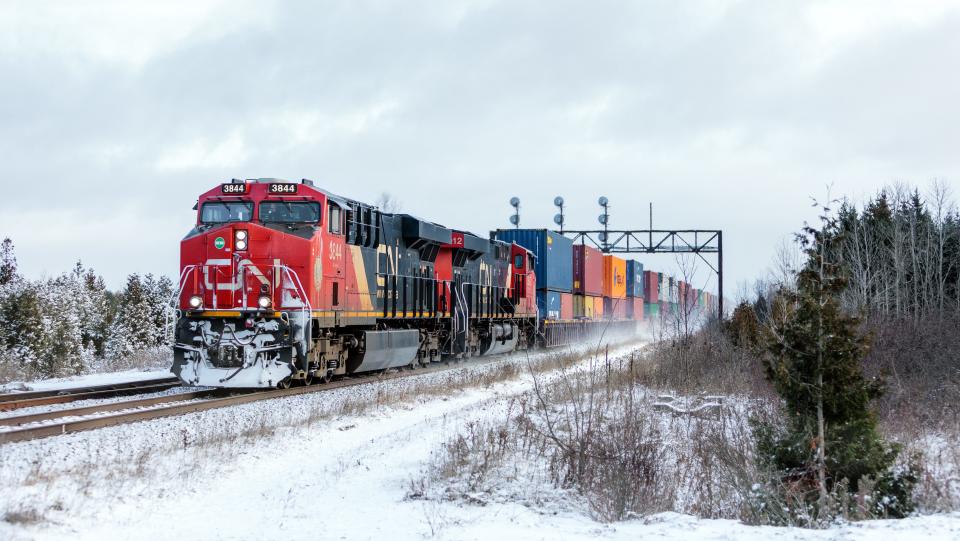CN prepared for winter despite regulatory uncertainty

Canadian railway CN is prepared to handle low temperatures and heavy snowfall this winter, but it warns that new regulations could test its ability to meet customer demand and keep the supply chain flowing, according to the 2023-2024 winter plan that it recently submitted to the Canadian government.
“As the season and our operational plan evolve, we will continue to collaborate with our customers and supply chain partners to further fine‑tune our plan,” President and CEO Tracy Robinson said in the plan’s introduction. “By working together as one holistic supply chain, and not as individual parts, we can create further capacity and adapt more effectively to the challenges of the winter season.”
The railway urged the Canadian government to be aware of how regulatory measures, such as expanding interswitching, can hinder how the railway does business. CN (NYSE: CNI) argued that extending interswitching distances from a 30-kilometer (18.6-mile) radius to a 160-kilometer (99.4-mile) radius “forces railways to dedicate resources to inefficient movements,” while new duty and rest period rules put into question the availability of its workforce.
“CN’s operating crew base has increased steadily over the past 18 months in anticipation of new federal regulations,” CN said in its winter plan. “However, the full impact of the new federal regulations on CN’s rail operations remains unclear and is a wild card heading into the 2023–2024 winter. … The combined impact of these new regulations is still uncertain. Experience has shown us that tough winter conditions ‘burn’ capacity since shorter, slower trains still need locomotives and employees to operate them, which significantly reduces productivity.”
“The full measure of these regulatory changes will be tested for the first time this winter as operational adjustments will be required to maintain existing customer service levels,” CN continued, adding that its initial analysis of the changes “shows that hundreds of additional personnel will be required in Canada (mostly in the West) to do the same amount of work as was done prior to the implementation of the regulations.”
CN produced the plan to comply with section 151.01(2) of the Canada Transportation Act. The full report, which includes further details about how CN expects to handle different commodities during winter, is available here.
Regardless of uncertainties over regulatory impacts, CN said it will be working with customers and taking steps to reduce dwell time and increase network velocity, while also ensuring safe operations. That includes running shorter trains when temperatures drop below minus 25 C (minus 13 F), which translates into utilizing more locomotives and crews; adjusting the volume of local rail feeder lines to match the capacity of the mainline; sharing information and customer forecasts to ensure there are enough people and equipment available; and performing proactive maintenance such as using distributed power and air braking rail cars, CN said.
“Winter is a defining feature of Canada’s character,” the plan states. “For more than 100 seasons, CN has dealt with and learned from winter’s harsh reality. The lessons learned over the years help inform the steps we take to mitigate winter’s impact on our operations.”
CN cited lessons from last winter.
“While not as harsh as the previous year’s winter, the winter of 2022-2023 can be considered a typical Canadian winter and far from a mild one,” CN said. “Key learnings include the importance of working closely with all supply chain partners to coordinate train loadings and unloadings with network capacity in real time, taking into consideration ambient weather conditions. We also saw the benefits of being proactive and anticipating the need for tier restrictions and implementing them sooner to ensure network fluidity was maintained during periods of extreme cold. This also helped corridor operations recover more quickly after cold snaps. These learnings will be very useful going into next winter, which CN anticipates will be in line with the five‑year average.”
Subscribe to FreightWaves’ e-newsletters and get the latest insights on freight right in your inbox.
Click here for more FreightWaves articles by Joanna Marsh.
Related links:
The post CN prepared for winter despite regulatory uncertainty appeared first on FreightWaves.
